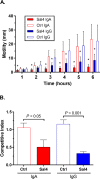Inhibition of invasive salmonella by orally administered IgA and IgG monoclonal antibodies
- PMID: 32203503
- PMCID: PMC7117778
- DOI: 10.1371/journal.pntd.0007803
Inhibition of invasive salmonella by orally administered IgA and IgG monoclonal antibodies
Abstract
Non-typhoidal Salmonella enterica strains, including serovar Typhimurium (STm), are an emerging cause of invasive disease among children and the immunocompromised, especially in regions of sub-Saharan Africa. STm invades the intestinal mucosa through Peyer's patch tissues before disseminating systemically. While vaccine development efforts are ongoing, the emergence of multidrug resistant strains of STm affirms the need to seek alternative strategies to protect high-risk individuals from infection. In this report, we investigated the potential of an orally administered O5 serotype-specific IgA monoclonal antibody (mAb), called Sal4, to prevent infection of invasive Salmonella enterica serovar Typhimurium (STm) in mice. Sal4 IgA was delivered to mice prior to or concurrently with STm challenge. Infectivity was measured as bacterial burden in Peyer's patch tissues one day after challenge. Using this model, we defined the minimal amount of Sal4 IgA required to significantly reduce STm uptake into Peyer's patches. The relative efficacy of Sal4 in dimeric and secretory IgA (SIgA) forms was compared. To assess the role of isotype in oral passive immunization, we engineered a recombinant IgG1 mAb carrying the Sal4 variable regions and evaluated its ability to block invasion of STm into epithelial cells in vitro and Peyer's patch tissues. Our results demonstrate the potential of orally administered monoclonal IgA and SIgA, but not IgG, to passively immunize against invasive Salmonella. Nonetheless, the prophylactic window of IgA/SIgA in the mouse was on the order of minutes, underscoring the need to develop formulations to protect mAbs in the gastric environment and to permit sustained release in the small intestine.
Conflict of interest statement
AR, JD, SL, GW, and NM declare that no competing interests exist. MP, KW, and LZ are employees of MappBio, Inc.
Figures






References
-
- Kotloff KL, Nataro JP, Blackwelder WC, Nasrin D, Farag TH, Panchalingam S, et al. Burden and aetiology of diarrhoeal disease in infants and young children in developing countries (the Global Enteric Multicenter Study, GEMS): a prospective, case-control study. The Lancet. 2013;382(9888):209–22. 10.1016/s0140-6736(13)60844-2 - DOI - PubMed
-
- O'Ryan M, Vidal R, del Canto F, Carlos Salazar J, Montero D. Vaccines for viral and bacterial pathogens causing acute gastroenteritis: Part II: Vaccines for Shigella, Salmonella, enterotoxigenic E. coli (ETEC) enterohemorragic E. coli (EHEC) and Campylobacter jejuni. Hum Vaccin Immunother. 2015;11(3):601–19. Epub 2015/02/26. 10.1080/21645515.2015.1011578 - DOI - PMC - PubMed
-
- Kotloff KL, Nasrin D, Blackwelder WC, Wu Y, Farag T, Panchalingham S, et al. The incidence, aetiology, and adverse clinical consequences of less severe diarrhoeal episodes among infants and children residing in low-income and middle-income countries: a 12-month case-control study as a follow-on to the Global Enteric Multicenter Study (GEMS). The Lancet Global Health. 2019;7(5):e568–e84. 10.1016/S2214-109X(19)30076-2 - DOI - PMC - PubMed
Publication types
MeSH terms
Substances
LinkOut - more resources
Full Text Sources
Molecular Biology Databases
Miscellaneous

